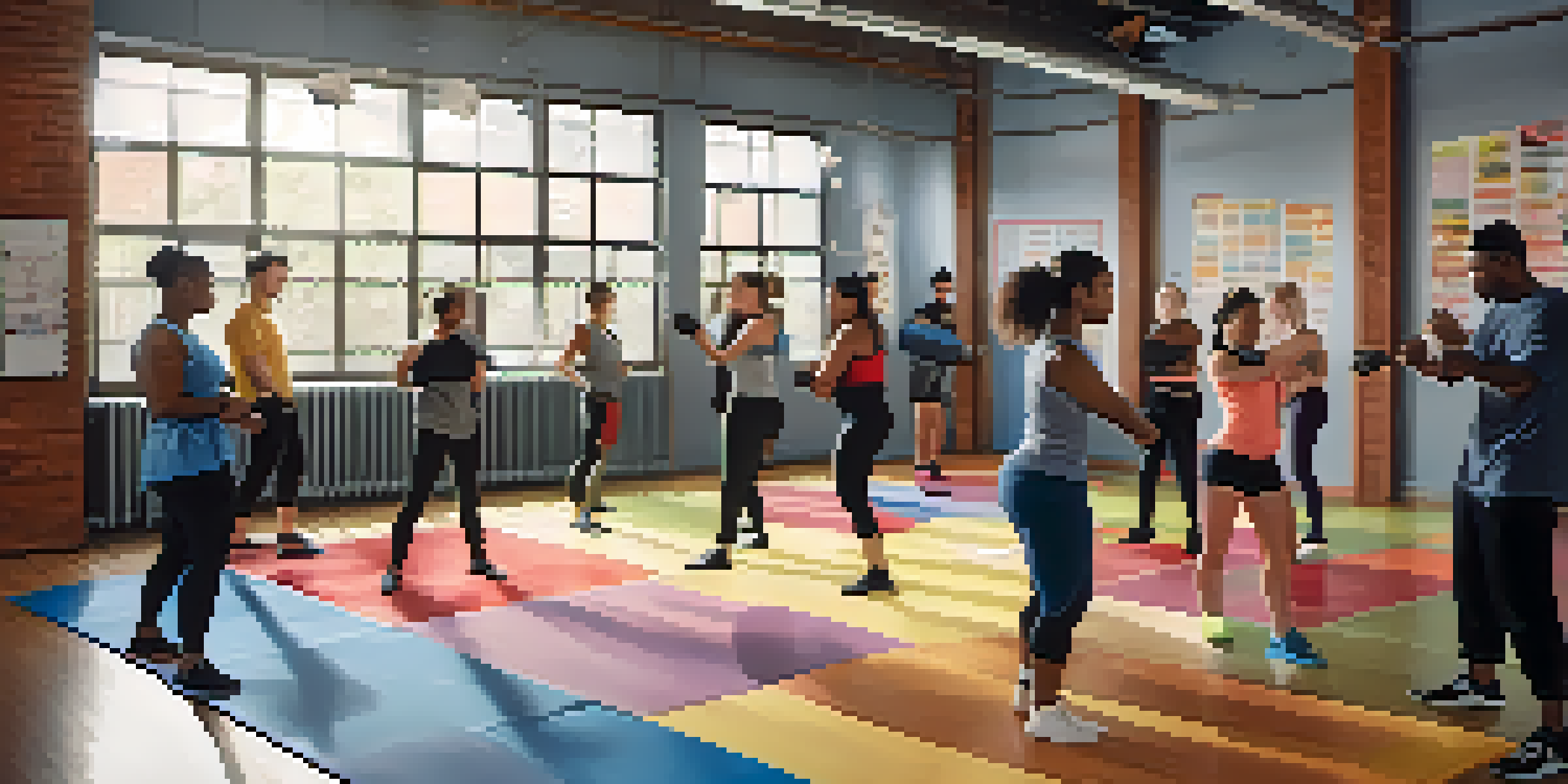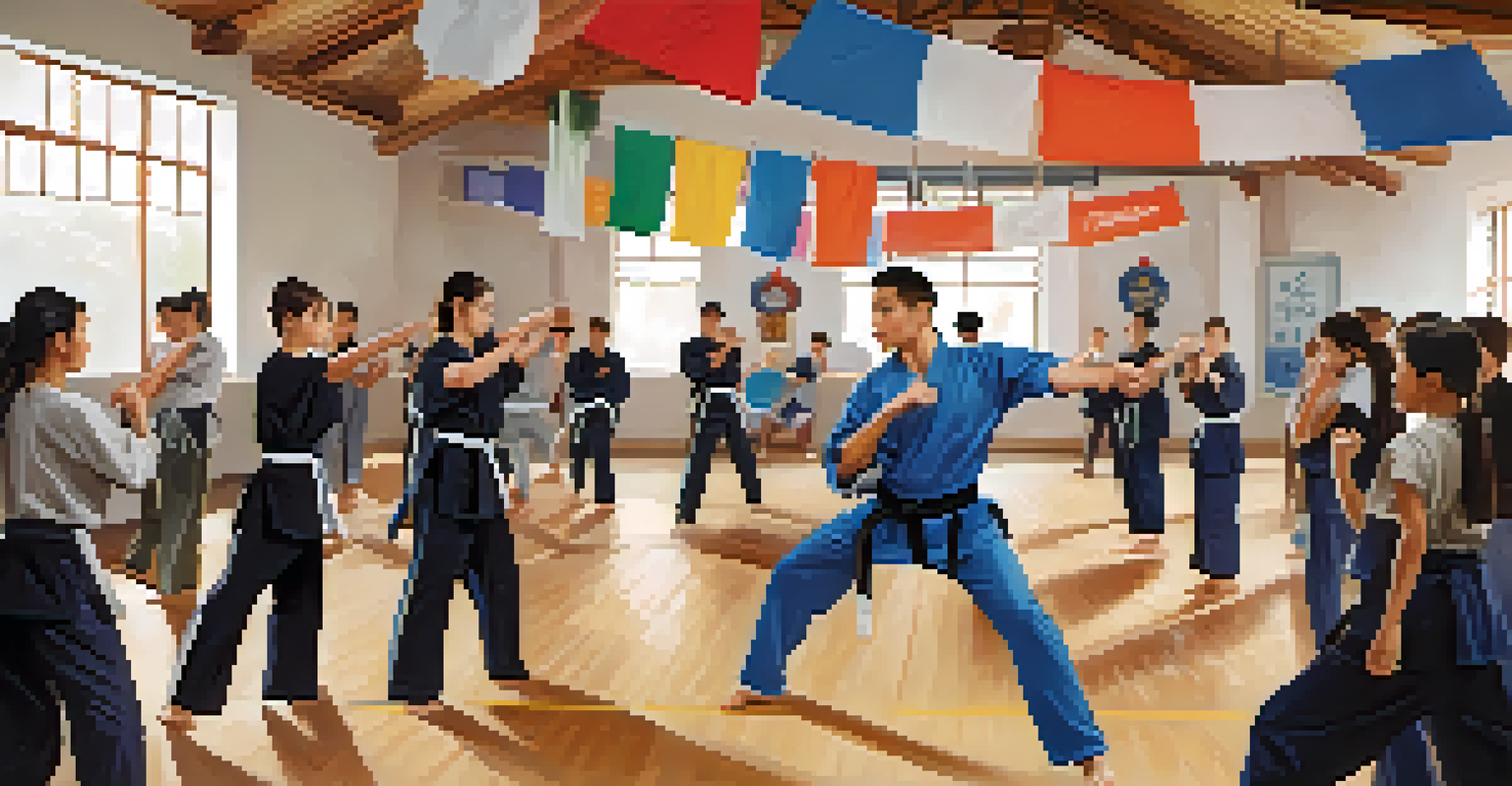Understanding Gender Dynamics in Self Defense Training

The Importance of Self Defense for Everyone
Self-defense training is vital for individuals of all genders, as it empowers people to protect themselves in potentially dangerous situations. Regardless of gender, everyone should feel safe and confident in their ability to respond to threats. This training not only covers physical techniques but also instills a mindset of awareness and preparedness. By understanding the importance of self-defense, we can foster a culture of safety for all.
The best defense is a good offense.
Moreover, self-defense is more than just physical skills; it's about cultivating assertiveness and confidence. When individuals engage in self-defense training, they learn to trust their instincts and make quick decisions under pressure. This psychological aspect is crucial, as it helps dismantle the societal norms that often discourage people from standing up for themselves. Thus, self-defense becomes a powerful tool for personal empowerment.
Incorporating self-defense into one's routine can drastically improve overall well-being. It encourages physical fitness, mental resilience, and social interaction, bringing individuals together in a shared goal of safety. Ultimately, self-defense training cultivates a supportive community where everyone learns to respect and protect one another, regardless of gender.
Gender-Specific Challenges in Self Defense
While self-defense training is essential for all, different genders face unique challenges that can affect their training experience. For instance, women and non-binary individuals may encounter societal stereotypes that undermine their confidence in their physical capabilities. Understanding these gender-specific challenges helps instructors tailor their approaches and create a more inclusive environment for all participants.

In many cultures, traditional gender roles can inhibit individuals from seeking self-defense training. Men, for example, may feel pressured to conform to ideals of toughness and aggression, while women might be discouraged from asserting their strength. Acknowledging these societal pressures is key to framing self-defense as a necessary skill for everyone, regardless of gender expectations.
Self-Defense Empowers Everyone
Self-defense training fosters confidence and awareness, enabling individuals to protect themselves and contribute to a culture of safety.
These challenges emphasize the need for supportive instructors who can address these issues head-on. By fostering an environment that encourages open conversations, instructors can help participants feel safe and empowered to learn. This inclusivity not only enhances the training experience but also builds a community that values mutual respect and understanding.
Techniques: Adapting to Different Body Types
Self-defense techniques can vary significantly depending on the practitioner's body type, which is often linked to gender. For example, individuals with smaller frames may benefit from leveraging speed and agility rather than relying solely on strength. This adaptability is crucial in teaching everyone practical skills that they can implement effectively in real-life situations.
Self-defense is not just a physical skill; it's a mindset that empowers individuals to assert their boundaries.
Instructors should emphasize techniques that are adaptable for all body types, ensuring that every participant feels capable of defending themselves. This may include teaching tactics that focus on escaping rather than engaging, which can be effective for individuals of any size. By understanding the physical attributes of different genders, trainers can provide a more customized approach to self-defense education.
Additionally, practicing a variety of techniques helps build confidence and reinforces the idea that everyone has the potential to defend themselves. When participants see that they can execute techniques designed for their body type, it fosters a sense of empowerment. Ultimately, the goal is to make self-defense accessible, effective, and inclusive.
Building Confidence Through Training
Confidence is a cornerstone of effective self-defense, and training plays a vital role in building that confidence. Regular practice allows individuals to become familiar with techniques, making them feel more comfortable in high-pressure situations. This transformation can be particularly impactful for those who may have previously felt vulnerable or uncertain about their ability to defend themselves.
Moreover, self-defense training provides a safe space for individuals to confront their fears and anxieties. Through gradual exposure to challenging scenarios, participants learn to trust their instincts and reactions. This psychological resilience not only enhances their self-defense skills but also positively influences their daily lives, as they start to approach challenges with a newfound confidence.
Addressing Gender-Specific Challenges
Recognizing unique challenges faced by different genders allows for tailored self-defense training that creates an inclusive environment.
As individuals progress in their training, they often find a sense of community and support among their peers. This camaraderie reinforces the idea that they are not alone in their journey towards empowerment. By collectively working towards personal growth, participants can inspire each other and foster an environment where confidence thrives.
The Role of Awareness in Self Defense
Awareness is a critical component of self-defense that transcends physical techniques. It's about being attuned to your surroundings and recognizing potential threats before they escalate. Self-defense training often emphasizes the importance of maintaining awareness, as it can prevent dangerous situations from occurring in the first place.
Understanding situational awareness also helps individuals develop a proactive mindset. This means training oneself to notice suspicious behavior or uncomfortable situations, empowering them to take action before they become victims. By incorporating awareness into self-defense training, participants learn that prevention is just as important as response.
Finally, fostering awareness can lead to stronger intuition and better decision-making skills. This heightened perception allows individuals to assess situations quickly and respond appropriately. Ultimately, incorporating awareness into self-defense training not only prepares individuals for physical confrontations but also equips them with invaluable life skills.
Creating Inclusive Training Environments
Creating an inclusive self-defense training environment is essential for fostering participation from all genders. Instructors can achieve this by using language that is neutral and supportive, avoiding terms that may alienate or discourage certain groups. Additionally, emphasizing a culture of respect and encouragement can help participants feel safe and valued in their training.
Diversity in instructional staff can also enhance inclusivity. When participants see instructors who reflect a range of backgrounds and experiences, it can inspire confidence and trust. This representation can make the training feel more relatable and affirming for all individuals, encouraging them to engage fully in the learning process.
Inclusivity Enhances Training Experience
Creating an inclusive training space encourages participation, builds community, and ensures that everyone feels valued and empowered.
Moreover, incorporating feedback from participants can help refine training methods and ensure that everyone feels heard. Regularly checking in with students about their experiences creates an open dialogue that fosters community and trust. By prioritizing inclusivity, we can create an environment where everyone feels empowered to learn and grow.
The Future of Gender Dynamics in Self Defense Training
As society progresses, understanding gender dynamics in self-defense training will continue to evolve. Training programs that adapt to the needs of diverse populations will be essential in promoting safety and empowerment for all. This evolution may involve integrating new techniques and philosophies that address the unique challenges faced by different genders.
Furthermore, increased awareness and advocacy for gender inclusivity in self-defense can drive positive change in training programs. As more individuals recognize the importance of equitable training experiences, there will be a greater push for organizations to implement inclusive practices. This change will ultimately benefit everyone by creating a richer training environment.

Finally, ongoing research and dialogue around these dynamics will help shape the future of self-defense training. By encouraging conversations about gender and safety, we can continue to break down barriers and create a community where everyone feels empowered to learn and defend themselves. The future is bright for inclusive self-defense training, paving the way for a safer world.